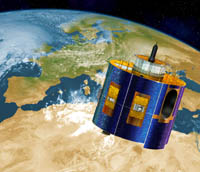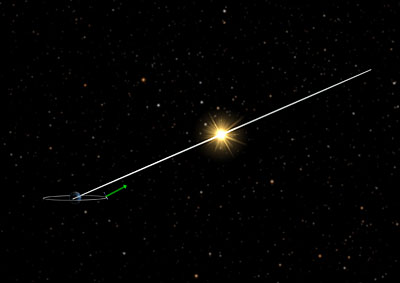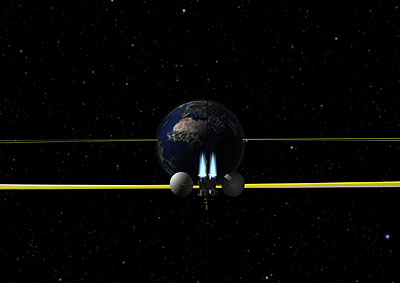GEOSTATIONARY ORBIT
A geostationary orbit is an almost circular orbit around the Earth and it is equatorial. This means that the plane of the orbit has no inclination with respect to the equatorial plane. The satellite is positioned at a distance from the equator of around 36,000 km and the time it takes to make a complete revolution around the Earth is 24 hours, which is equal to the time of the Earth's rotation around its axis.
If a satellite has a geostationary orbit, an observer on the Earth, looking towards the sky, will see the satellite stationary. The satellite looks always at the same portion of the Earth's surface.
The geostationary orbit is typical of the Telecommunication and Meteorological Satellites. A satellite with this type of high orbit does not provide good spatial resolution, that is, however, not required for observations of the cloud system on the continents.
 Meteosat
Second Generation (Credits.
ESA- D.Ducros 2002)
Meteosat
Second Generation (Credits.
ESA- D.Ducros 2002)
A satellite in geostationary orbit is affected by several perturbations. The main perturbations are due to the gravitational pull of the Sun and the Moon, to the fact that the Earth has not a spherical shape and to the solar radiation pressure. These perturbations alter the position of the satellite over time. For this reason a control program is needed to position the satellite. The maximum permitted tolerances for the displacement in longitude, latitude and elevation of the satellite are defined, to its reference position. The whole of these tolerances define a portion of space in which the satellite is bound to remain; this volume is said Station Keeping Box. The aim of the Station Keeping is to compensate for the effects of perturbations on the position of the satellite. Therefore, periodic orbit corrections are made to keep the satellite into the maximum permitted limits. These operations involve the activation of the thrusters of the satellite.


Solar radiation pressure (Credits: ESA)..........................................................................................Station keeping for a GEO satellite (Credits: ESA)